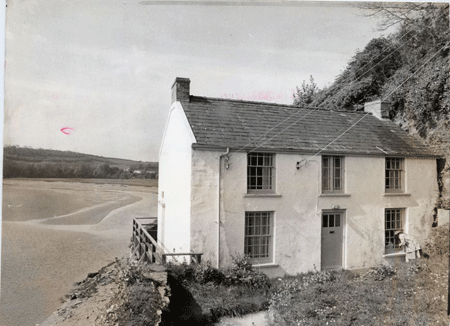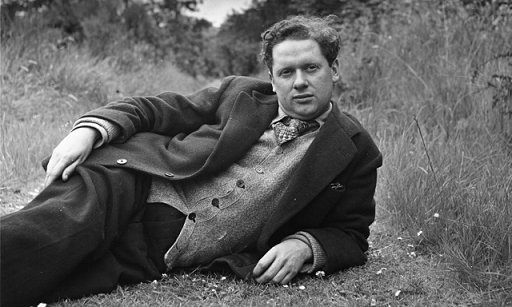Travels in Time and Wales with Dylan, the Doctor and Annie
A version of this travel piece originally appeared in The Herald (Ireland) in May.

It’s fair to say that if you are on a travel job that will take you to locations associated with the great Welsh poet Dylan Thomas (1914—1953) then you don’t expect one of the first shrines that you come across to be to a character from Torchwood, a television spin-off of Dr. Who.
I’ve just booked into the St. David’s Hotel & Spa in the Welsh capital of Cardiff and I’m taking advantage of a very early flight to have a look around the hugely impressive Bay area.
Here there is a Wetlands Reserve where mudflats have been transformed into freshwater marshland and a beautiful 500-acre lake. Or perhaps in keeping with our science-fiction opening I should use that lovely word ‘terraformed!’ Whatever you call it, the view from the hotel over breakfast is not at all a bad way to start the day; and if anything the spectacle from my second-floor room is even better. The Welsh have done a great job on the entire Bay area, with no shortage of interesting places to visit. Yes, including the Dr. Who Experience, which is obviously a must for fans. As to that shrine to a character called Ianto Jones, five minutes’ walk from the hotel on Mermaid Quay, it seems from the letters and photographs left there that enthusiasts come from all over the world to see it. Odd. Then again, I like ‘odd’. Which is just as well, because the Harbour Authority has ‘erected’ close to the hotel front what looks like the largest phallic symbol in Wales. No kidding; it appears to have escaped from a Ken Russell movie.
An afternoon trip to Cardiff Castle reveals several more layers of ‘odd’.
Although the original Roman foundations have been added to over the course of nearly 2,000 years, it was really when the third Marquess of Bute came into his enormous inheritance in 1868, that the castle began to assume the shape it holds today. He seems to have just let loose an architect by the name of William Burges, who had hitherto gone over budget on anything he worked on. Here there was no budget and the result is an eyeball-searing explosion of colour from the moment that you enter the first room. This is medieval life, Jim, but not as we know it. It is fantasy medieval, a riot produced by two imaginations in tandem and with so many stories being laid out in symbols that it would take multiple visits to achieve anything approaching the full benefit of it.
Preserved in Amber: 5, Cwmdonkin Drive
The following day we set off to Swansea to look for the remains of Dylan Thomas’s world, in this his centenary; and where better to begin than with his childhood home at 5, Cwmdonkin Drive? This has been lovingly, meticulously restored by Geoff Haden and his ex-wife Annie, two hardcore Thomas admirers. Geoff is highly entertaining as he shows us around and does a wonderful impression of Prince Charles on his visit there. (“Is that eiderdown? I love eiderdown; reminds me of Grandmother’s bed…”) It is also possible to rent the house to stay in for the night. Again, odd; or perhaps not. It depends on how Dylan-obsessed you are. I know that I would jump at the chance to stay in Robert E. Howard’s old room in Cross Plains, Texas; so…each to their own.
Annie stays with us for the rest of the trip and it is fair to say that it wouldn’t have been the same without her. Almost a force of Nature, her enthusiasm is contagious as she shows us around Cwmdonkin Park, so prominent in Dylan’s work. Annie herself has a rather poetic way of speaking.
“The land hasn’t forgotten that it was once swamp…” she says at one point; and then again: “‘I can fly’, the boy once said; and he did, but he didn’t use the wind.
“Dylan was a Time Lord, plucking things from the past when he wrote and settling them down twenty years later.”
There’s no escaping Dr. Who on this trip.
Mad About the Boy
Whether intentional or not, it becomes clear over the course of the next couple of days that Annie doesn’t care too much for Thomas’s father David, but does feel a deep emotional attachment for the poet that she often refers to simply as ‘the boy’. (Although her feelings towards his mother, Florence, are the polar opposite. Indeed, she has begun a yearly remembrance on her birthday called Welsh Mam’s Day.)
“The boy was shy, emotionally insecure and with a dad who was not only anti-social but quite often drunk. He was also a frustrated poet himself and seems to have been jealous of his son to the extent that he could never tell him: Well done.”
And I guess that he wouldn’t have been the first young man to overcompensate for his shyness by overindulging in drink. Although, like Annie, I rather think that this has been exaggerated, not least by Thomas himself, who loved the image, as he proved at a talk in Rome in 1947:
“One: I am a Welshman; two: I am a drunkard; three: I am a lover of the human race, especially of women.”
Despite these insights and a surprisingly moving visit to the Dylan Thomas Centre I feel that it’s fair to say that little remains in Swansea that the ghost of the poet would recognize. Much of that atmosphere is kept alive through sheer force of will from people like Annie and Geoff.
Then it was on to Laugharne, where Dylan spent his last four years, living in his famous ‘Boathouse’ and drinking in Brown’s Hotel. The trip there makes Wales come alive for me, as Annie regales us with anecdotes on the small towns that we are passing through. I feel saturated by the past and find myself thinking—hardly for the first time– of the short distance between Christianity and Paganism. And as always, Annie brings things alive with her stream-of-consciousness musings:
“Ah, here’s Gower: it has its own character, its own way of living. It is lovely in its difference. And watch out for the red-painted farmhouses as we drive on. They are the colour of words. They are the earth’s blood-colour.”

Laugharne itself is just lovely and a visit to Dylan’s grave and cross is a must (“complex in its simplicity” as Annie puts it) and I must confess to a personal preference here: despite the excellence of the St. David’s the previous night, I preferred the more earthy charms of an evening in Browns Hotel. Be warned, though: this is very much a pub with rooms, no matter how nice those rooms are. It is likely that when the bar is full you might find it too noisy, depending on which room you are in.
I feel as if Laugharne is the kind of small, quiet place that I could live in; and of course I’m enchanted with the Boathouse and the shed where Dylan Thomas worked. I could imagine writing there during the day and then walking on down to the pub for the evening; but Annie is having none of that:
“It’s too easy to romanticize it. It wasn’t idyllic. You see that because you’re well-fed and full-pocketed. [Well, I’ll put my hands up to the first part, missus!] They were lower-town and when he had money he was the most generous of men; but all too often it was a hand-to-mouth existence with children, a dog and a wife who was often a harridan.”
Point taken.
I feel, though, that if you want to evoke the spirit of Dylan Thomas then a visit to Laugharne is simply essential.

Factfile
This was my first trip to Wales and most certainly made me want to go back as soon as possible. The trip from Swansea to Laugharne was through country that, helped by Annie’s very subjective viewpoint, had me feeling that I was about to enter the world of an early Phil Rickman novel. I made the hour-long flight from Dublin to Cardiff with Aer Arran and stayed in the excellent St. David’s Hotel and Spa, where rooms are advertised as starting from the knock-down price of €52—although at this time of the year I would advise taking that as starting from €88. Their restaurant is nothing short of excellent, following what I’m told was a brief dip in standards.
A room in Dylan Thomas’s drinking place, Brown’s Hotel, starts at €104 with breakfast.
I loved a lunch that we had in a town with the wonderful name of Mumbles, at Patrick’s with Rooms. And a real pleasure was an outstanding meal in The Cors, a renovated country home in the heart of Laugharne and yet somehow seemingly ‘hidden away’.
For info on the Dylan Thomas House see www.cwmdonkindrive.com
For all the information you could need concerning a visit to this intriguing country I’d recommend: www.visitwales.com

Recent Comments